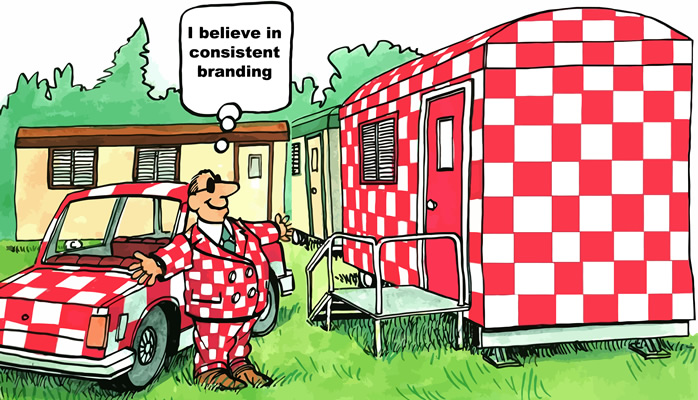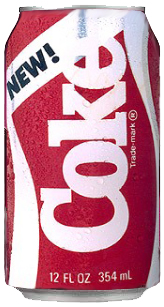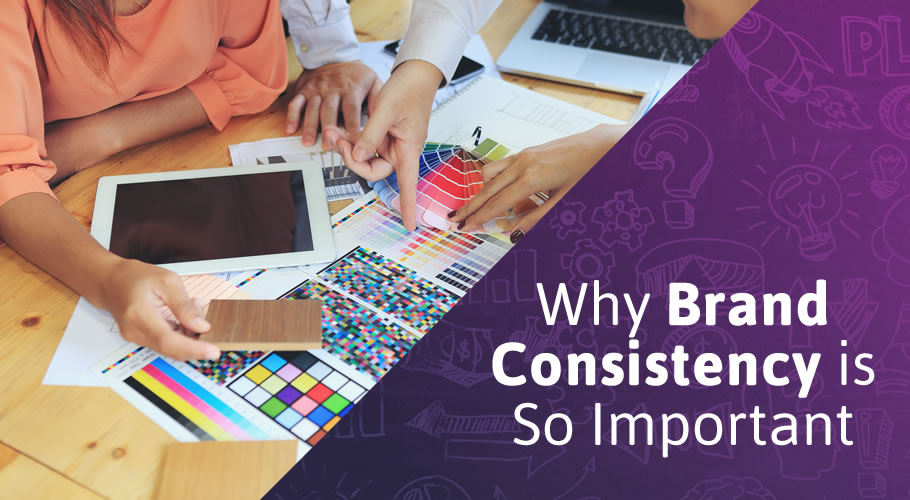When you’ve been helping business owners to build their brands for as long as I have, you learn a thing or two about brand consistency, and why it’s so important.
But what is a brand anyway?
The term gets thrown around a lot, but in my experience, a lot of people (business owners included) would be unable to define it.
Many people think it’s just a logo or a website, but the truth is, it’s much more than that. A brand is not only what people see when your business is presented to them, but also what they feel.
At the end of the day, your audience’s perception of you and your business is what defines your brand, and it’s that feeling or perception that can make or break your business.
But if you’re constantly switching things up on your audience, and you’re not maintaining consistency in your branding, things can quickly go awry, creating devastating consequences for you and your business.
I’ve seen countless examples of this over the years from both clients, and legendary brands that have had to face the consequences of breaking their brand consistency.
So, if you want to know how to develop a successful brand, and you’re wondering how brand consistency works, then you should definitely keep reading.
Because in this article, I’m going to explain what brand consistency is, offer some tips to help you maintain that consistency, and highlight some of the worst examples of what can happen when brands lack consistency.
What Is Brand Consistency?

As I said above, the term brand refers to the way your audience feels about your business, and the way they perceive it.
That being said, brand consistency refers to maintaining a consistent look, feel, and narrative throughout all of your branding, and avoiding any break in that continuity.
At the same time, it also refers to your branding being consistent with what defines your business.
This allows you to have much greater control over the way your business is perceived, and the way potential customers feel about your brand, and this is vitally important to the success of your business.
Consistent branding can offer many additional benefits, including:
- Creating trust and the perception that your business is reliable
- Making your business more memorable
- Establishing an emotional connection with potential customers
- Building credibility and establishing you as an authority in your field
- Providing a solid base to help grow your business with loyal followers
- Saving you time and money by helping you to get established more quickly
- Attracting ideal customers who are looking for exactly what you have to offer
I’m sure some of you would disagree, and maybe you’ve thought, “If I don’t change things up and get creative, then I won’t get noticed, people won’t see my content, and I’m going to lose my competitive edge.”
But this mode of thinking is completely counterintuitive.
You see, part of what gives brands their competitive edge, and their ability to be memorable and instantly recognizable is in the way they differentiate themselves.
But if your branding is constantly changing, how can you expect to distinguish yourself and ensure consumers will recognize your branding when they see it?
And if you’re using inauthentic, disingenuous, or haphazard branding, how can you expect people to trust you or take you seriously?
Short answer: you can’t.
If you don’t maintain consistency in your branding, you’ll confuse potential customers, they won’t recognize you, and before you know it, you’ll be all but forgotten.
Even many legendary, well-established brands have paid the price for using inconsistent branding.
But I’ll get into that a bit more in a minute.
READ: How to Define Brand Identity and Maintain Consistency in All Your Marketing Materials
If you want to maintain consistency in your branding, the first thing you’ve got to do is figure out what your brand is all about.
So, if you’re unsure about how to define your brand, and you want to learn more about how to maintain consistency in your branding, then this article is right up your alley.
It explores how you can define your brand identity, and how to maintain consistent branding on your website, social media, and in your images and videos, among many other things.
How Can I Maintain Brand Consistency?
If you want to maintain brand consistency, you’ve got to ensure your business retains a uniform look across all its branding and marketing materials.
Simultaneously, your branding needs to be genuine, and it needs to align with your business model.
This includes not only how you present yourself in public or on social media (as in what you say, how you behave, or the way you look), but also how your brand is presented from a visual perspective.
This aspect is key because it’s the visual brand of your business that will really work to differentiate you from your competition and make you more recognizable.
That being said, let’s explore some aspects of your branding and how you can keep things consistent in those areas.
Brand Voice
Your brand voice is defined by the personality, values, vernacular, and all other aspects of the way your business communicates its message to the world.
So, whether you’re sending out a newsletter, drafting website copy, designing display ads, or something else entirely, make sure to keep that voice consistent by speaking in the same authentic tone and communicating the same message across all your marketing channels.
Visual Brand
Your visual brand is defined by the overall flow, style, and feel of things like your logo, brand colours, and typography, along with the shapes and images you use to market your business.
This is an area where you can easily confuse potential customers, who’ve hopefully come to recognize and respect your visual branding.
For instance, if your logo is red and blue, and you decide to suddenly change it to be green and purple, it’s going to dilute what distinguishes you from the competition, which makes you less recognizable, and you might end up alienating your customers, so don’t do it.
Formatting
This might seem like a pretty minor thing, but trust me, it’s not.
For example, let’s say you just started a new series of articles on your blog, which are all neatly formatted and contain enticing imagery to break up the text.
Then, one day you’re in a rush to publish something, so you omit the images and slap it together as fast as you can.
Not only would this make you look amateurish, but again, it dilutes what differentiates you, and it’ll probably make people less likely to want to read your articles.
So, if you have a format for your marketing materials, make sure it accurately reflects what you do, and make sure you stick to it.
Colours
The colours you use for your branding are crucial for defining the identity of your brand and ensuring it remains memorable and has a distinct look.
Every last aspect of your branding and marketing should follow this colour palette.
That means the colour scheme used for your logo should fit in with the colours you use for everything from the design of your website to your business cards, and perhaps even the clothes you wear.
I know it might sound silly, but you really can go that deep when ensuring consistency in your branding.
As you can see from the video below, every last aspect of this video reflects eVision Media’s brand and its colours – from the purple and green plants, to the penguins, and even the clothes I’m wearing.
Fonts
Similar to colours, fonts do a lot of heavy lifting when it comes to defining your brand identity, and if you choose the wrong ones, it can be disastrous.
This aspect of your brand offers yet another reminder that not only should your branding remain consistent in terms of its continuity, but the elements you choose to use for your branding should also be consistent with what defines your business.
For example, if you own a company that installs furnaces, you should probably avoid using a font that looks like letters carved out of ice, like this one:

So, when it comes to fonts, you’ve got to make sure they accurately depict your brand, and you should pick no more than two or three fonts to use for all your branding, and avoid changing them at all costs.
Epic Fails of Inconsistent Branding
After reading through this section, I know some of you might try to correct me and say these are just rebrands gone wrong, rather than examples of inconsistent branding.
And while that may be true from one perspective, at its core, a rebrand does represent a break in continuity, and a diminution of brand consistency.
At any rate, these bloopers offer some of the most informative examples of what can go wrong when businesses lack consistency in their branding.
Coca-Cola
 Back in 1975, as part of the cola wars between iconic soft drink brands, Pepsi and Coca-Cola, Pepsi launched the Pepsi Challenge.
Back in 1975, as part of the cola wars between iconic soft drink brands, Pepsi and Coca-Cola, Pepsi launched the Pepsi Challenge.
This marketing campaign involved Pepsi staging blind taste tests in public locations, like shopping malls, encouraging consumers to taste both Coke and Pepsi in unlabelled paper cups, and asking them which was their favourite before revealing what was in each cup.
At least according to Pepsi, the campaign found that most Americans preferred Pepsi over Coke.
Then, about ten years after the Pepsi Challenge’s inception, Coca-Cola made one of the biggest blunders in the history of branding.
The company actually changed the formula of Coca-Cola, making it taste slightly different, and released it under the name New Coke.
The reaction from American consumers was decidedly negative, and within a few months, Coca-Cola reintroduced its original formula, rebranded as Coca-Cola Classic.
Obviously, this wasn’t the death knell for Coca-Cola, as the legendary brand is still very much alive and well today, but it does offer a poignant example of how tampering with the consistency of your brand can alienate customers and end up being a complete embarrassment.
BP
Formerly known as British Petroleum, BP is a U.K.-based corporation, known for being one of the largest oil and gas companies in the world.
Back in 2010, the company became a household name for all the wrong reasons, as they were responsible for one of the worst industrial disasters in modern history, the Deepwater Horizon explosion, and subsequent oil spill, which resulted in several deaths and injuries, along with the spilling of about 5 million barrels of oil into the Gulf of Mexico.
Having been founded in 1909, the company has gone through about half a dozen versions of its logo, with most of them resembling a green and yellow shield.
However, as you can see below, in 2000, they changed the logo they’d been using for decades to a green, yellow, and white sun, which looks suspiciously like a flower, and oozes environmentalism.

Now, even though the logo change occurred before the Deepwater Horizon disaster, simply by virtue of the fact that it’s an oil company, BP’s new logo was mercilessly ridiculed, and for good reason.
I mean, when your main source of revenue comes from processing and distributing fuels, lubricants, and other petrochemicals, and you’re best known for things like explosions, oil spills, and chemical leaks, it’s pretty disingenuous to brand your business as an organization that cares about the environment.
BP’s website even claims that the company wants to reduce carbon emissions and “help the world reach net zero”, which is laughable considering crude oil is made primarily of hydrocarbons.
It may not be responsible for a loss of profits, but because this branding is so misaligned with BP’s business model, it’s embarrassing, it shows a severe lack of self-awareness, and it erodes BP’s credibility.
In any case, this is one of the worst examples I’ve seen of branding that’s simply inconsistent with what a business is all about, and it offers a much-needed reminder that not only should branding have continuity, but it also needs to be genuine, and accurately reflect what your business actually does.
Are you still wondering how to develop a successful brand? Think you could use the help of an online brand specialist? We’ve been helping business owners to build their brands for more than 20 years. Contact us to learn how we can help you build your brand.
To your business success,
Susan Friesen
P.S. If you liked the article, you might want to subscribe to our newsletter. We publish tons of valuable content to help you learn more about marketing, and subscribing is the best way to ensure you don’t miss out. Additionally, if you’d like to learn more about building a search engine optimized website, click here for our free website guide.









